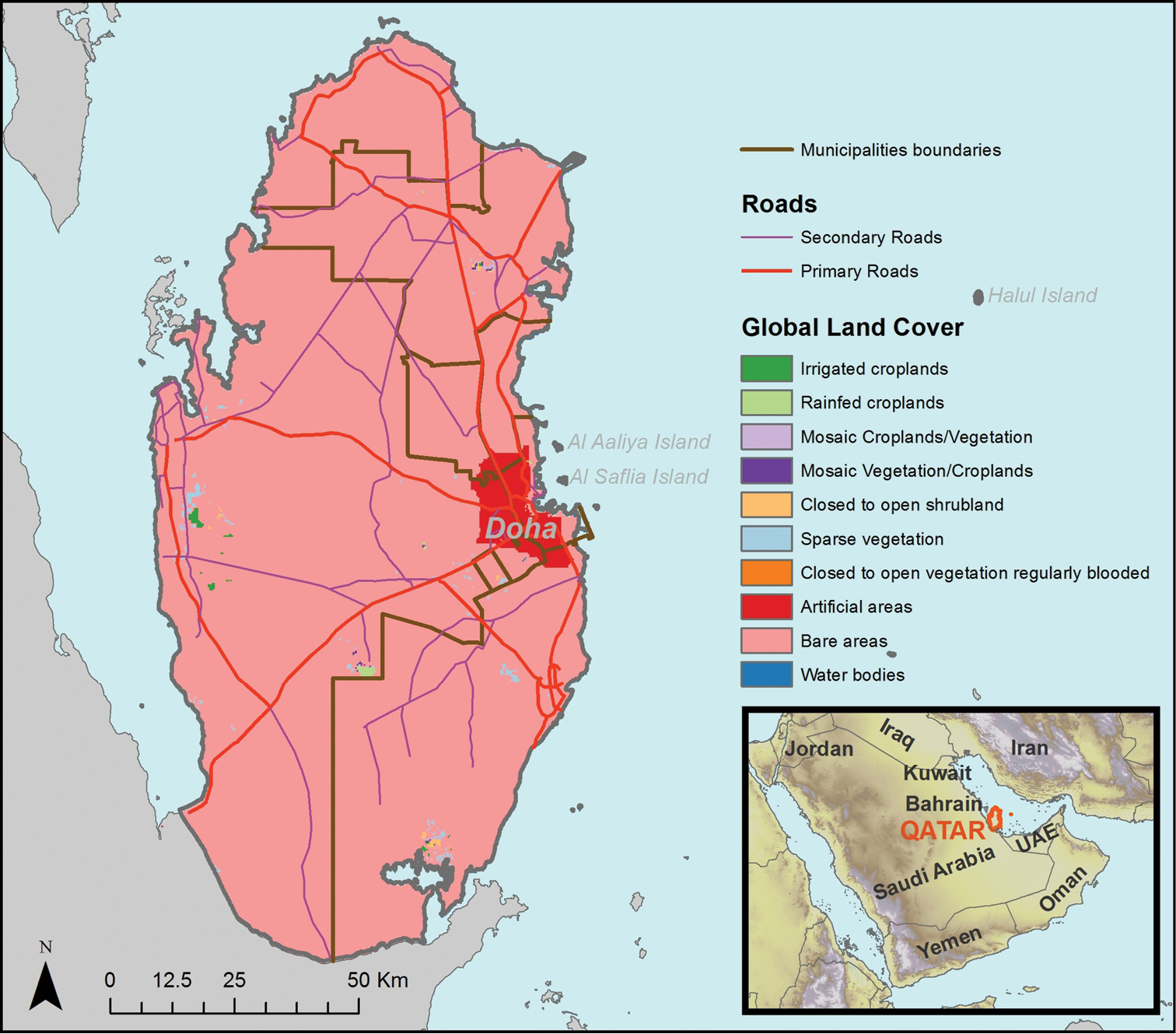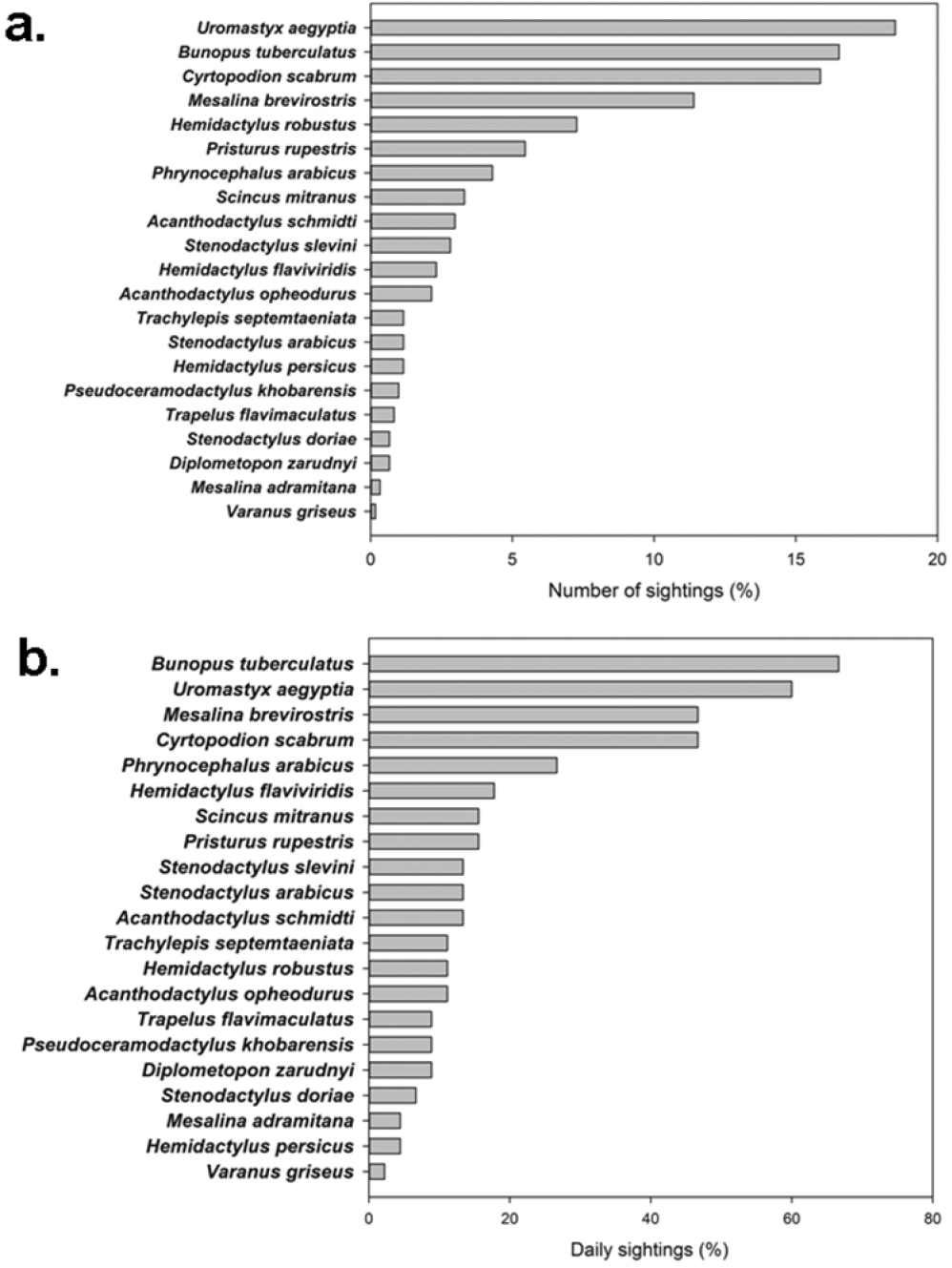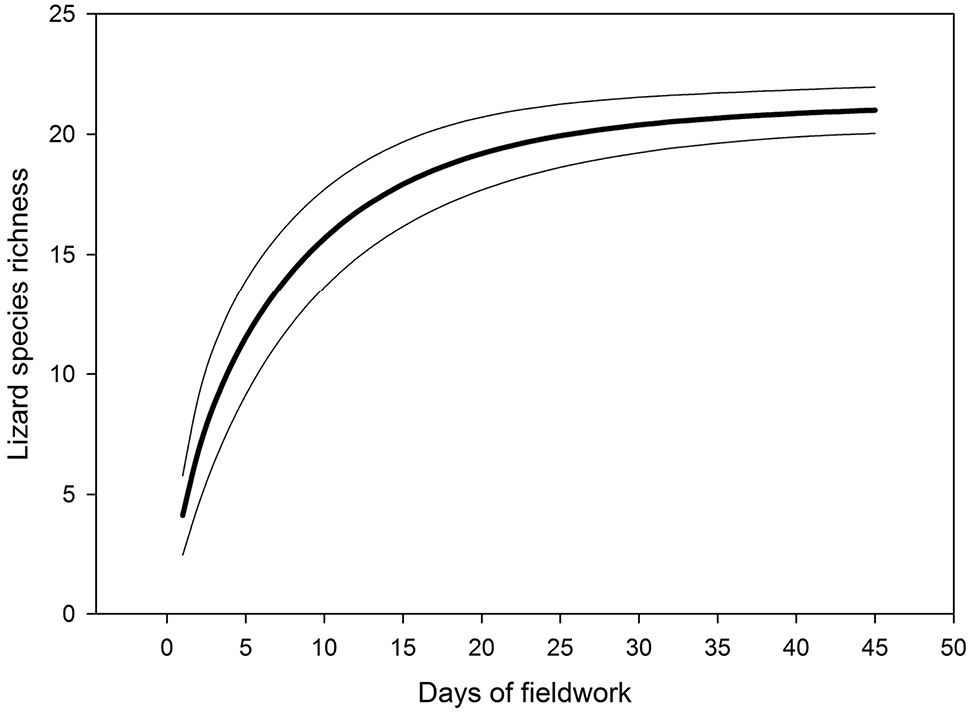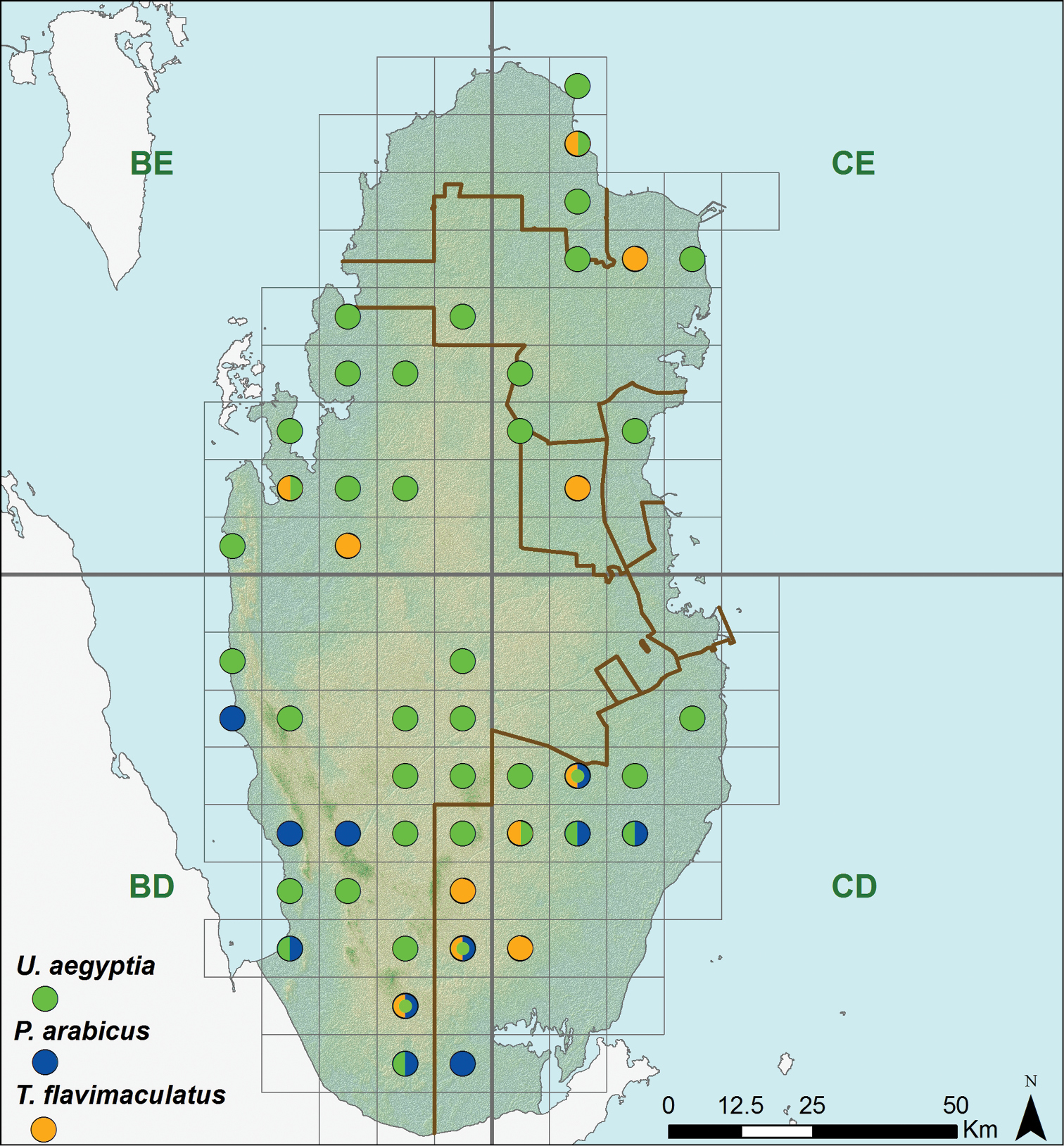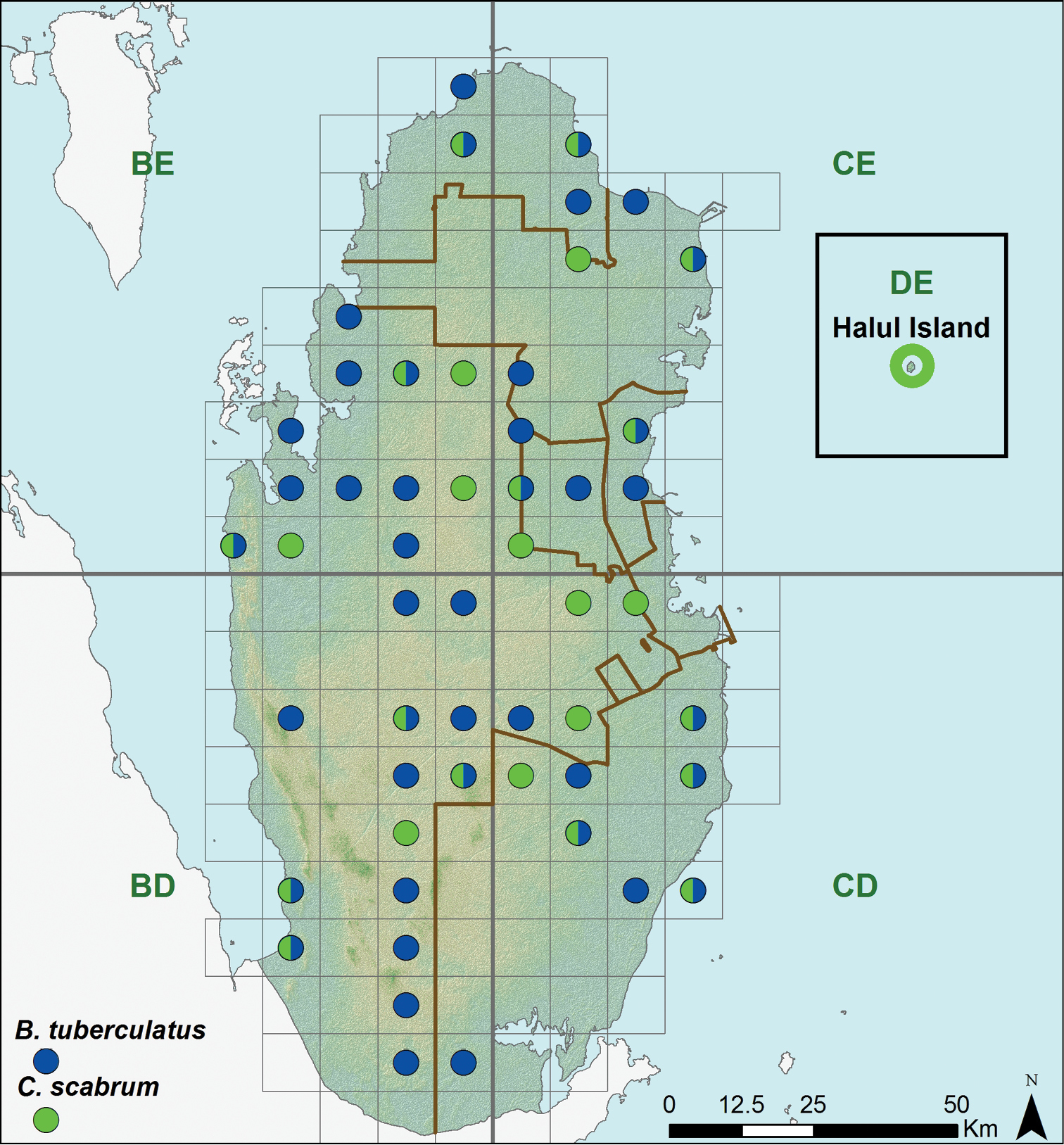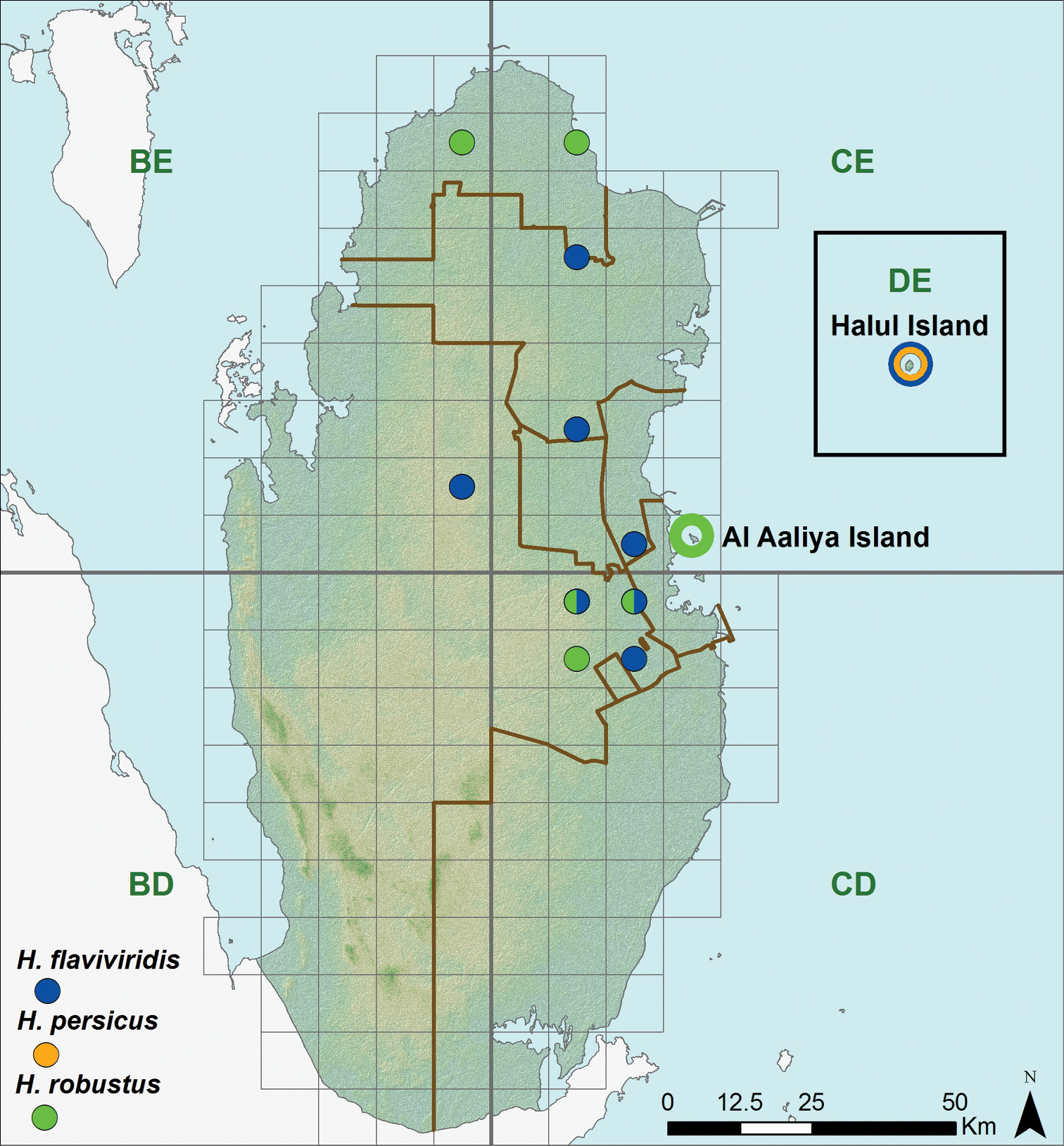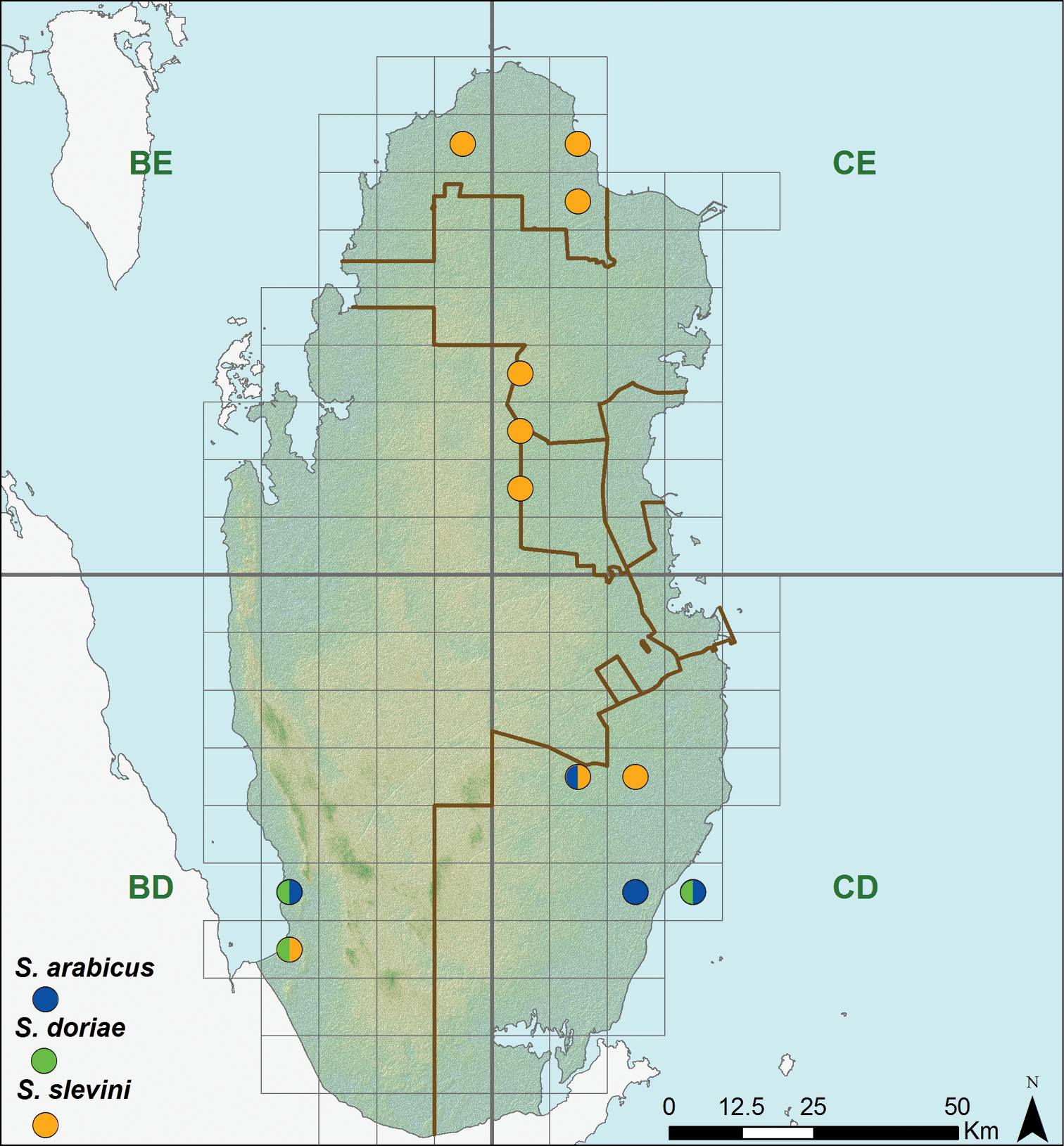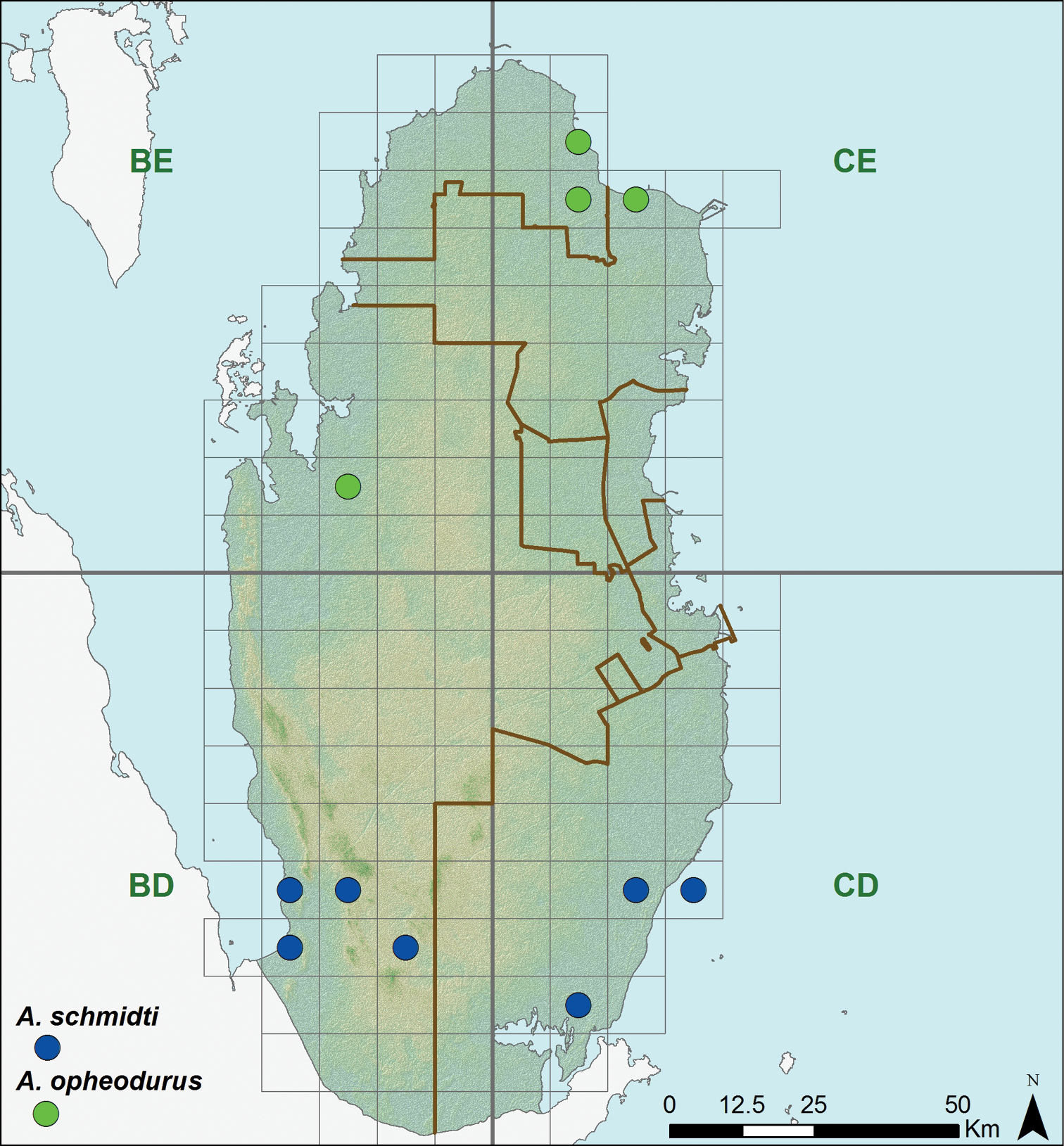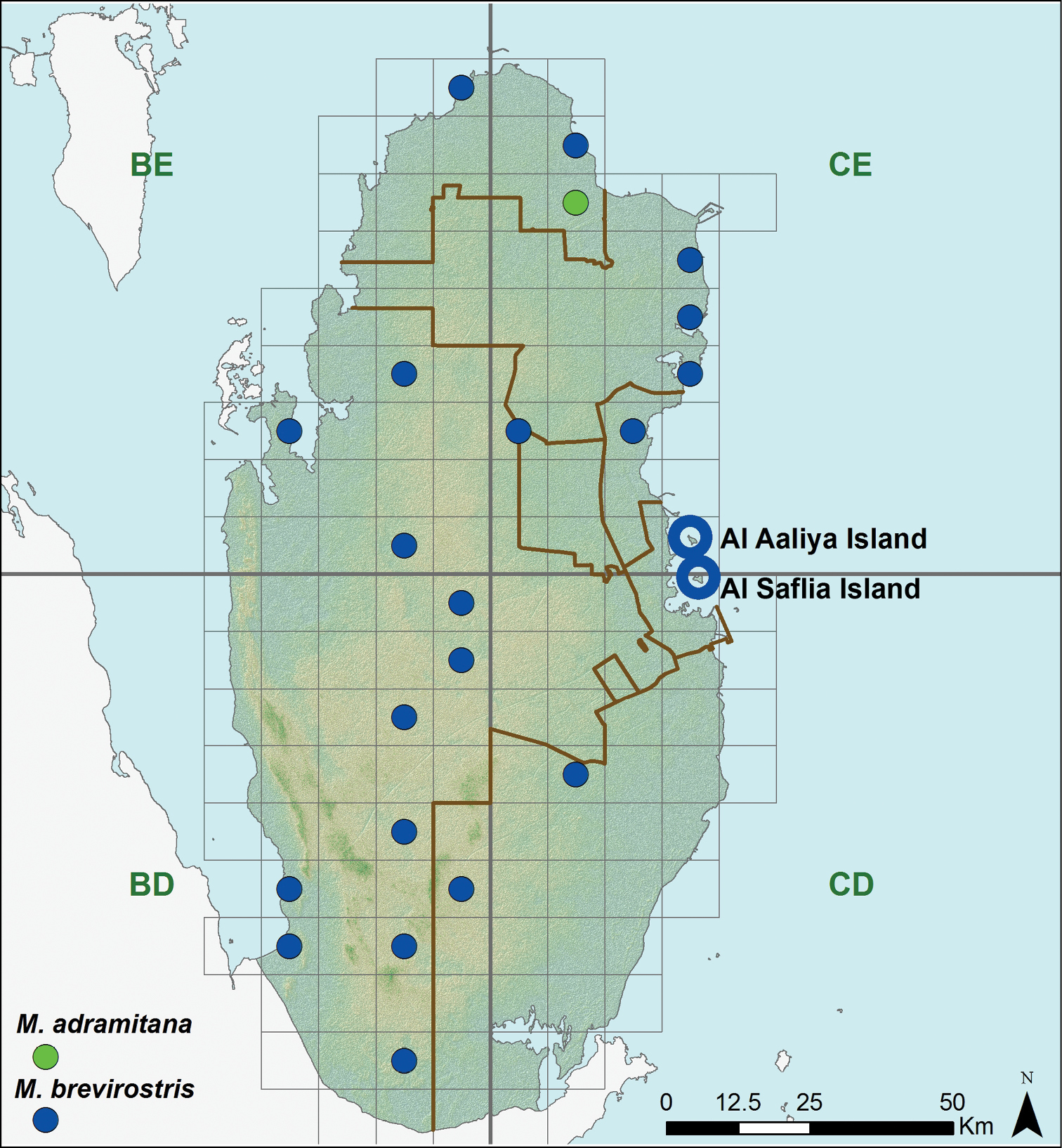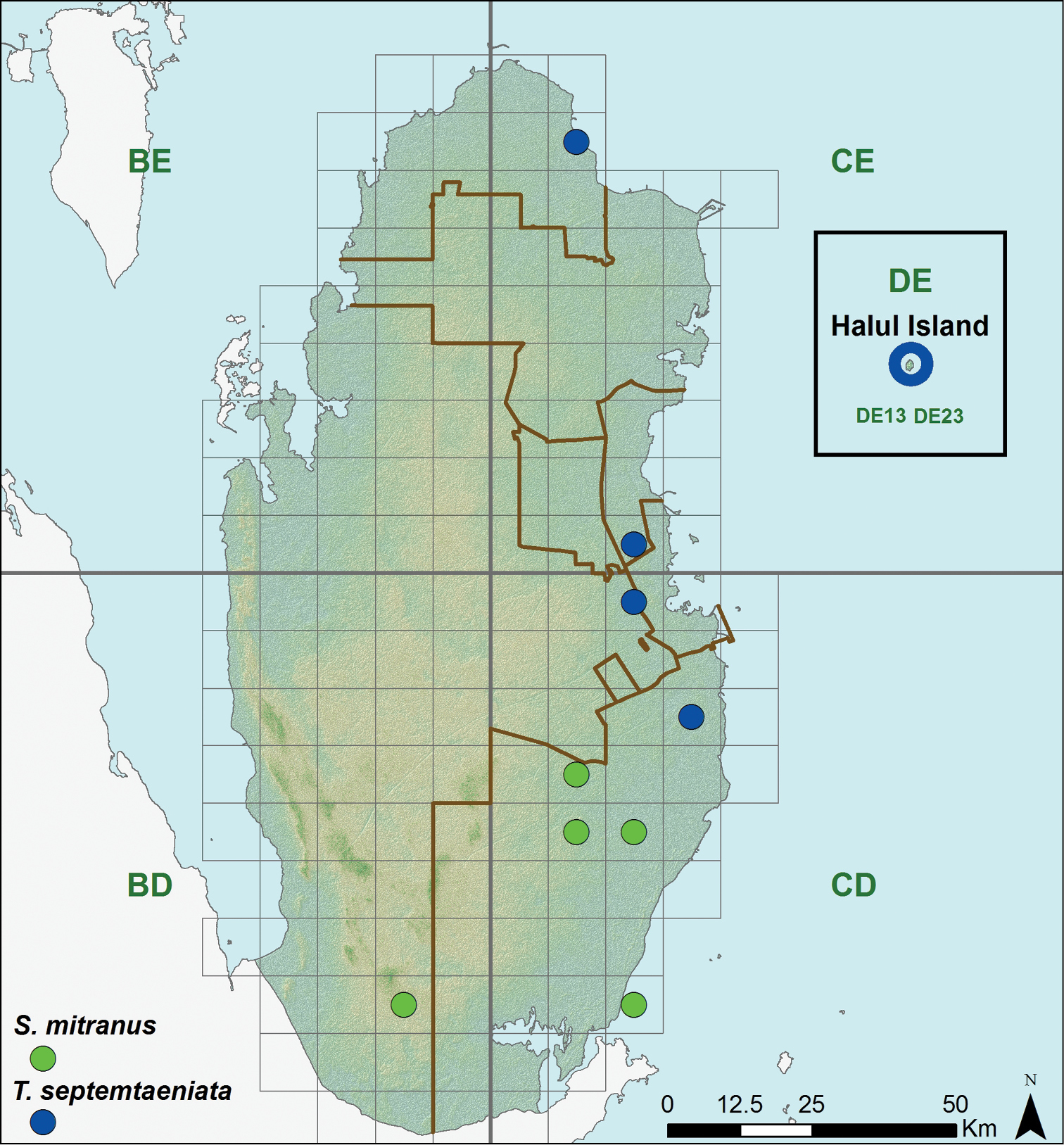






(C) 2014 Dan Cogălniceanu. This is an open access article distributed under the terms of the Creative Commons Attribution License (CC BY 4.0), which permits unrestricted use, distribution, and reproduction in any medium, provided the original author and source are credited.
For reference, use of the paginated PDF or printed version of this article is recommended.
Citation: Cogălniceanu D, Castilla AM, Valdeón A, Gosá A, Al-Jaidah N, Alkuwary A, Saifelnasr EOH, Mas-Peinado P, Richer R, Al-Hemaidi AAM (2014) A preliminary report on the distribution of lizards in Qatar. ZooKeys 373: 67–91. doi: 10.3897/zookeys.373.5994
We have updated the list of the lizard species present in Qatar and produced the first distribution maps based on two field surveys in 2012 and 2013. We used the QND95/Qatar National Grid with a grid of 10 × 10 km squares for mapping. Our results show the occurrence of 21 lizard species in Qatar, from the 15 species indicated in the last biodiversity report conducted in 2004. The most abundant family found in Qatar is Gekkonidae with nine species (Bunopus tuberculatus, Cyrtopodion scabrum, Hemidactylus robustus, H. flaviviridis, H. persicus, Stenodactylus arabicus, S. slevini, S. doriae, Pseudoceramodactylus khobarensis), followed by Lacertidae with four species (Acanthodactylus schmidti, A. opheodurus, Mesalina brevirostris, M. adramitana), Agamidae with three species (Trapelus flavimaculatus, Uromastyx aegyptia, Phrynocephalus arabicus), Scincidae with two species (Scincus mitranus, Trachylepis septemtaeniata), and Varanidae (Varanus griseus), Sphaerodactylidae (Pristurus rupestris) and Trogonophiidae (Diplometopon zarudnyi) with one species each. The species richness fluctuated largely across Qatar between one and eleven species per grid square. We believe that the lizard fauna records in Qatar are still incomplete and that additional studies are required. However, our study here fills a gap concerning lizard biodiversity knowledge in the Gulf Region.
Reptilia, geographic distribution, species richness, inventory, maps, biodiversity, atlas
The rapid worldwide decline of reptiles has raised concerns about their conservation and the urgent need for action (
The state of Qatar is a peninsula with an area of 11, 571 km2 that lies between 24–27°N and 50–52°E (Figure 1). The peninsula projects 186 km north from Saudi Arabia and varies in width between 55 and 90 km. Much of the country is flat with a highest elevation of 103m. Global Land Cover v2.3 identifies 10 coverage categories in Qatar (Figure 1,
Location of Qatar within the Arabian Peninsula, and general map of Qatar. Global Land Cover was obtained from GlobCover 2.3 (
The lizard fauna of Qatar is poorly known. Apart from the study of
The inventory of lizard species present in Qatar was conducted during 45 days of field work in October 2012 (15 days) and in March-May 2013 (30 days), with an average time of 6 hours per day spent searching for lizards (range 3–10 hours/day). The surveys were conducted in the mainland and in three islands. Halul Island (25.67N, 52.40E) is in the E of Qatar at 81.5 km from the nearest coast in Al-Khor. Al Aaliya Island (25.41N, 51.56E) is situated at 2.5 km from the Eastern coast near Doha city. Al Saflia Island (25.34N, 51.58E) is also in the Eastern coast at a distance of 3.1 km from Doha. Al Aaliya and Al Saflia islands are separated by 5.5 km. The methods used for the inventory varied according to the habitat and time of the day, and are consistent with
The majority of the data included in the final distribution maps come from our own surveys. However, we have also added three records from publications of Qatar University (
To make the distribution maps we proceeded as follows. The GPS geocoordinates were exported to ArcGIS 10 (ESRI) to create a shapefile, which was projected to the official reference system in the country, QND95/Qatar National Grid (
Species richness per square was calculated as the number of species detected in each 10 × 10 km square. We used two relative measures as estimators of species abundance: (i) The percentage of daily sightings, measured as the number of days a certain species was observed from the total number of fieldwork days (n = 45), so we did not consider multiple sightings of the same species. (ii) The percentage of overall sightings. This was calculated as the number of times a species was observed from the total number of sightings (n = 617). We used presence-absence data for computing a species accumulation curve (SAC) and five non-parametric estimators of species richness (ICE, Chao 2, Jackknife 1, Bootstrap and Michaelis-Menten) using EstimateS 9 (
During the 45 days of field surveys we observed a total of 865 individual lizards ranging from 5 to 35 per day (average of 19 individuals/day). The total number of species sightings is lower (617), since for some species several individuals were located close together, usually under the same shelter.
We inventoried 21 species of lizards belonging to seven families: Gekkonidae with nine species, Lacertidae with four species, Agamidae with three, Scincidae with two and Varanidae, Trogonophiidae and Sphaerodactylidae with one species each (Table 1). The number of lizard species observed per day ranged between 1 to 10 (average of 4.1 ± 2.1). In the island Al Saflia we only found two species (Pseudoceramodactylus khobarensis and Mesalina brevirostris), in Al Aaliya island we found three species (Pseudoceramodactylus khobarensis, Mesalina brevirostris and Hemidactylus robustus), and in Halul island we found five species (Hemidactylus persicus, Hemidactylus flaviviridis, Cyrtopodion scabrum, Pristurus rupestris and Trachylepis septemtaeniata). Based on our measurements of relative abundance, we found that four species of lizards appear to be the most abundant: Bunopus tuberculatus, Cyrtopodion scabrum, Uromastyx aegyptia and Mesalina brevirostris (Figure 2). The species accumulation curve approaches a plateau, suggesting that the majority of species present has been inventoried (Figure 3). The use of non-parametric estimators of species richness supports this statement indicating that only 2–4 species of lizards remain to be discovered (estimator, mean value ± standard deviation): ICE 23.61 ± 0.01, Chao 2 25.83 ± 5.86, Jackknife 1 25.83 ± 2.01, Bootstrap 23.11, and Michaelis-Menten 24.63. The preliminary lizard species richness varied largely across Qatar between 1–11 species per grid square (Figure 4). The distribution maps for the 21 lizard species in Qatar are presented in Figures 5–13, and Figure 14 shows the photos of the lizards.
Lizard species inventoried in Qatar during the surveys conducted in 2012–2013, and publications where the species (or other species probably mistaken with correct species) are recorded for the first time in Qatar.
| Species | Family | First record in Qatar |
|---|---|---|
| Pristurus rupestris Blanford, 1874 (a) | Sphaerodactylidae | |
| Pseudoceramodactylus khobarensis Haas, 1957 | Gekkonidae | |
| Stenodactylus arabicus (Haas, 1957) | Gekkonidae | |
| Stenodactylus doriae (Blanford, 1874) (a) | Gekkonidae | |
| Stenodactylus slevini Haas, 1957 | Gekkonidae | |
| Bunopus tuberculatus Blanford, 1874 (a) | Gekkonidae | |
| Cyrtopodion scabrum (Heyden, 1827) | Gekkonidae | |
| Hemidactylus flaviviridis Rüppell, 1835 | Gekkonidae | |
| Hemidactylus persicus Anderson, 1872 | Gekkonidae | |
| Hemidactylus robustus Heyden, 1827 | Gekkonidae | |
| Scincus mitranus Anderson, 1871 | Scincidae | |
| Trachylepis septemtaeniata (Reuss, 1834) | Scincidae | |
| Diplometopon zarudnyi Nikolsky, 1907 | Trogonophiidae | |
| Mesalina adramitana (Boulenger, 1917) | Lacertidae | |
| Mesalina brevirostris Blanford, 1874 (b) | Lacertidae | |
| Acanthodactylus schmidti Haas, 1957 | Lacertidae | |
| Acanthodactylus opheodurus Arnold, 1980 | Lacertidae | |
| Varanus griseus (Daudin, 1803) | Varanidae | |
| Uromastyx aegyptia (Forskål, 1775) | Agamidae | |
| Phrynocephalus arabicus Anderson, 1894 | Agamidae | |
| Trapelus flavimaculatus Rüppell, 1835 | Agamidae |
Estimates of lizard species abundance based on a the proportion of sightings of a certain species from the total number of sightings (n = 617), and b the presence of a species per day from the total number of fieldwork days (n = 45) (see methods for details).
Species accumulation curve (bold line) reflecting lizard species richness based on presence-absence data for the whole country. The thin lines indicate the estimated error margins (95%).
Lizard species richness at a resolution of 100 km2.
Distribution of Diplometopon zarudnyi and Varanus griseus.
Distribution of three agamid species (Phrynocephalus arabicus, Trapelus flavimaculatus, Uromastyx aegyptia).
Distribution of Bunopus tuberculatus and Cyrtopodion scabrum.
Distribution of the species of the genus Hemidactylus.
Distribution of Pseudoceramodactylus khobarensis and Pristurus rupestris.
Distribution of the species of the genus Stenodactylus.
Distribution of the species of the genus Acanthodactylus.
Distribution of the species of the genus Mesalina.
Distribution of Scincidae species (Scincus mitranus and Trachylepis septemtaeniata).
Photos of lizard species inventoried in Qatar (Author: Valdeón A, except for Diplometopon zarudnyi (Yamaguchi N)).
In this study we provide the first consistent list of lizard species for Qatar, and the first distribution maps based on field surveys. Our study fills a gap in the knowledge of lizard distributions in the Arabian Peninsula and in Qatar specifically. Except for the study of
During our surveys we attempted to collect data throughout the entire country; however this was not possible due to difficulties of accessing certain areas (e.g. industrial and private properties). The SE part of Qatar is difficult to access due to sandy soils and that was not fully sampled either. There are also differences in lizard species detectability due to differences in body size (e.g. maximum snout-vent length in Uromastyx aegyptia of 375 mm and only 32 mm in Pristurus rupestris (
The preliminary species distribution maps provided in this study allow, nevertheless, for further analysis on distribution patterns of abundance, rarity, richness and assemblage composition at larger spatial scales (
The reptiles of Qatar are threatened by the rapid human population growth that increased from several tens of thousand inhabitants to almost two million in the last century, habitat destruction caused by construction development, gas and oil extraction and transport facilities, and the introduction of alien species (especially cats). The human impact is unevenly distributed, with high human impact in and around Doha, moderate along the coast and low in the interior (
The distribution maps presented in this paper as visualized occurrence records fill a gap in the knowledge of biodiversity in Qatar, and will help the prioritization of conservation efforts and the identification of important conservation areas for lizards. This study is a first step in updating the Qatar databases of lizards and wildlife, with the goal to make scientific biodiversity data available and useful for the international community.
We acknowledge the logistic support of Qatar Foundation (particularly to Mr Faisal M Alsuwaidi, Dr Rabi Mohtar, Dr Khalid Al-Subai, Dr Ayman Bassil, Dr Chee Wen Chong, and Dr Mohammad Khaleel), the Ministry of the Environment (particularly to Eng. Ahmad M Al-Sada, Dr Rashid Al kuwari, Mr Fawaz Sowaidi, Mr Khaled Helal Al-Enazi, Mr Ghanim Abdulla Mohammed, Mr Mohamed Al-Jaidah, Mr Mohammed El-Mohanady, and Ms Mariam Al Dorseri); to the General Directorate of Natural Reserves (particularly to Mr Nawaf Jabr Al-Nuaimi); to Ras Laffan Industrial City (particularly to Dr Mohammad Albeldawi, Mr Leon Van Der Heyde, Mr Mr Salman Fahad Salman H. Al-Mohannadi, Mr Dhafer Dashen Al-Ajmi, Mr. Ramadorai Kadambi, Mr Jackie Wessel and Mr. Ahmed Chikhi), and to Qatar Petroleum (particularly to Mr Mohammed Ali Humaid and Eng. Khalifa Jassim Al-Malki). Many thanks to Dr Anthony Herrel, Mr John Tribuna, Dr Nobby Yamaguchi, Ms Elsa Naumann, Mr Mohamed Al-Jaidah, Mr Bassem Al Shaarani, Ms Mooza Al Mohannadi, Dr Rodrigo Riera, Dr Elena Bulmer and to many Qatari students (particularly to Ms Sara Al Naimi, Ms Dhabiya Al-Kubaisi, Ms Wadha Almarri and Adham Musthak), farmers and locals for their help during the field work or to provide us with the location and photos of some lizards. We also thank Dr. Roberto Sindaco for helpful comments on a previous version of this paper. AV was granted by the Department of Education of the Government of Navarra. This study has been possible by the Project #QF.00.307.722011.QE11 (Qatar Foundation) to Dr Aurora M Castilla.
